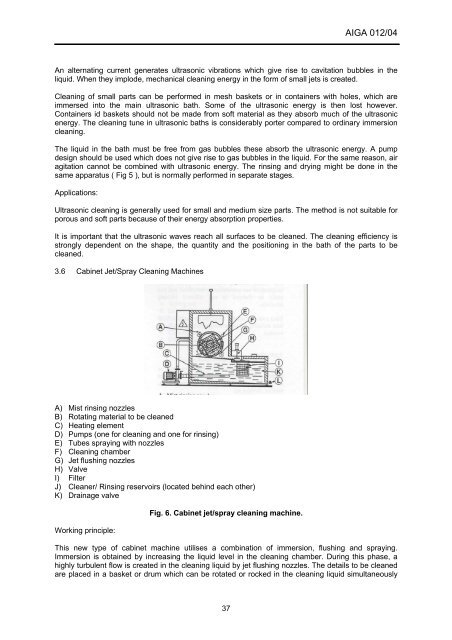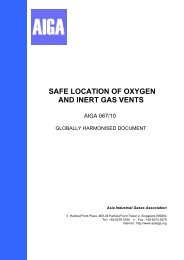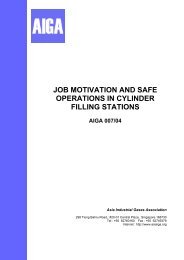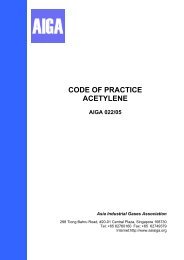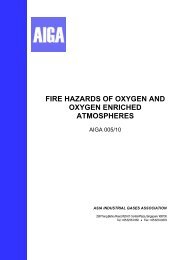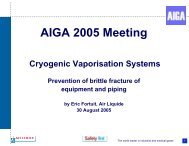CLEANING OF EQUIPMENT FOR OXYGEN SERVICE - AIGA
CLEANING OF EQUIPMENT FOR OXYGEN SERVICE - AIGA
CLEANING OF EQUIPMENT FOR OXYGEN SERVICE - AIGA
You also want an ePaper? Increase the reach of your titles
YUMPU automatically turns print PDFs into web optimized ePapers that Google loves.
37<br />
<strong>AIGA</strong> 012/04<br />
An alternating current generates ultrasonic vibrations which give rise to cavitation bubbles in the<br />
liquid. When they implode, mechanical cleaning energy in the form of small jets is created.<br />
Cleaning of small parts can be performed in mesh baskets or in containers with holes, which are<br />
immersed into the main ultrasonic bath. Some of the ultrasonic energy is then lost however.<br />
Containers id baskets should not be made from soft material as they absorb much of the ultrasonic<br />
energy. The cleaning tune in ultrasonic baths is considerably porter compared to ordinary immersion<br />
cleaning.<br />
The liquid in the bath must be free from gas bubbles these absorb the ultrasonic energy. A pump<br />
design should be used which does not give rise to gas bubbles in the liquid. For the same reason, air<br />
agitation cannot be combined with ultrasonic energy. The rinsing and drying might be done in the<br />
same apparatus ( Fig 5 ), but is normally performed in separate stages.<br />
Applications:<br />
Ultrasonic cleaning is generally used for small and medium size parts. The method is not suitable for<br />
porous and soft parts because of their energy absorption properties.<br />
It is important that the ultrasonic waves reach all surfaces to be cleaned. The cleaning efficiency is<br />
strongly dependent on the shape, the quantity and the positioning in the bath of the parts to be<br />
cleaned.<br />
3.6 Cabinet Jet/Spray Cleaning Machines<br />
A) Mist rinsing nozzles<br />
B) Rotating material to be cleaned<br />
C) Heating element<br />
D) Pumps (one for cleaning and one for rinsing)<br />
E) Tubes spraying with nozzles<br />
F) Cleaning chamber<br />
G) Jet flushing nozzles<br />
H) Valve<br />
I) Filter<br />
J) Cleaner/ Rinsing reservoirs (located behind each other)<br />
K) Drainage valve<br />
Working principle:<br />
Fig. 6. Cabinet jet/spray cleaning machine.<br />
This new type of cabinet machine utilises a combination of immersion, flushing and spraying.<br />
Immersion is obtained by increasing the liquid level in the cleaning chamber. During this phase, a<br />
highly turbulent flow is created in the cleaning liquid by jet flushing nozzles. The details to be cleaned<br />
are placed in a basket or drum which can be rotated or rocked in the cleaning liquid simultaneously


